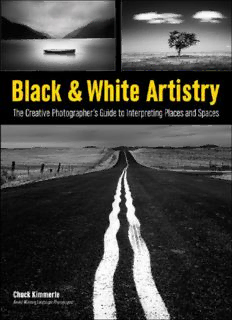
Black & White Artistry: The Creative Photographer's Guide to Interpreting Places and Spaces PDF
Preview Black & White Artistry: The Creative Photographer's Guide to Interpreting Places and Spaces
Copyright © 2016 by Chuck Kimmerle All rights reserved. All photographs by the author unless otherwise noted. Published by: Amherst Media, Inc., P.O. Box 586, Buffalo, N.Y. 14226, Fax: 716-874-4508 www.AmherstMedia.com Publisher: Craig Alesse Senior Editor/Production Manager: Michelle Perkins Editors: Barbara A. Lynch-Johnt, Harvey Goldstein, Beth Alesse Associate Publisher: Kate Neaverth Editorial Assistance from: Carey A. Miller, Sally Jarzab, John S. Loder Business Manager: Adam Richards Warehouse and Fulfillment Manager: Roger Singo ISBN-13: 978-1-60895-967-9 Library of Congress Control Number: 2015944877 10 9 8 7 6 5 4 3 2 1 No part of this publication may be reproduced, stored, or transmitted in any form or by any means, electronic, mechanical, photocopied, recorded or otherwise, without prior written consent from the publisher. Notice of Disclaimer: The information contained in this book is based on the author’s experience and opinions. The author and publisher will not be held liable for the use or misuse of the information in this book. www.facebook.com/AmherstMediaInc www.youtube.com/c/AmherstMedia www.twitter.com/AmherstMedia Contents Author’s Biography 1. Enlightened and Aware Photographer 2. Defining Landscape Photography 3. Why Black & White? 4. Photography Is Art Played in Two Parts 5. Technical Considerations in the Field 6. Photo Tartare, Keeping It RAW 7. Black & White Conversion 8. Subjects for Black & White 9. Scenes That Do Not Work 10. Previsualizing the Image 11. Exploring Our Surroundings 12. Destinations 13. Straight Landscape Photography 14. The Natural Landscape 15. Man’s Hand in the Landscape 16. Interpretive Landscape Photography 17. Graphic Landscapes 18. Wildlife in a Landscape Photograph 19. High Key Images 20. Low Key Images 21. Get Down and Funky 22. Become Intimate with Your Subject 23. The Myth of Bad Light 24. Studying the Light 25. Embracing the Sun 26. Flat Light 27. One Man’s Trash Is Another Man’s Photograph 1 28. One Man’s Trash Is Another Man’s Photograph 2 29. That Big, Beautiful Moon 30. Vernacular Structures: Exterior 31. Vernacular Structures: Interior 32. Surreal Subject Matter 33. The Simple Landscape 34. The Even Simpler Landscape 35. Embrace the Winter Snow 36. Whimsy 37. Long Exposure 1 38. Long Exposure 2 39. Cropping 40. Working the Scene 1: School Bus on Stilts 41. Working the Scene 2: The Church 42. Working the Scene 3: The Feather 43. Working the Scene 4: The Crosses 44. Working the Scene 5: Yucca and Joshua Tree 45. Eliciting a Response 46. The Score: The Pink Room, Part 1 47. The Performance: The Pink Room, Part 2 48. The Score: Cyclops Window, Part 1 49. The Performance: Cyclops Window, Part 2 50. The Performance: Chains Conversion In ACR 51. The Score: Rainbow, Part 1 52. The Performance: Rainbow, Part 2 53. The Performance: Shotgun Shells 54. The Performance: Zion Tree 55. A New Reality: Tree and Fence Lines 56. A New Reality: Tire Tracks in a Playa 57. Watch Those Corners 58. Camera Bag 59. Picking Our Glass 60. Conclusion Index Author’s Biography C huck Kimmerle is a black & white fine-art landscape photographer based out of Casper, Wyoming. He began his career as a staff photojournalist working at daily newspapers in Minnesota, Pennsylvania, and North Dakota, at the latter of which he was, as part of a small photography staff, a finalist for the 1998 Pulitzer Prize for Spot News Photography for coverage of a devastating flood. After leaving journalism, he chose the more relaxed and refined life of a staff photographer at the University of North Dakota, where he remained for the next ten years. Throughout the years of photojournalism and educational photography, he spent much of his free time photographing the landscape around which he lived. In 2010, Chuck transitioned to photographing the landscape when he resigned from his staff photographer position and followed his wife, Brenda Ling, to her new job in Wyoming. Chuck’s photography style has been called balanced and formal. His compositions are often simple and uncluttered, with objects frequently centered within the frame. To this day, he refuses to apologize for that great offense to those compositional hard-liners for whom the rule of thirds is an eleventh commandment. 1 Enlightened and Aware Photographer T here is a philosophy within the artistic community, in our case black & white photography, which states that art cannot be taught. The rationale is that artistic style and vision are dependent solely upon the individual, and any undue influence can only serve to dilute meaningful creativity. As far as photography is concerned, the technical aspects—exposure, camera specifics, Photoshop layers and masks, and so on—are easy to teach and fairly easy to learn. There are, literally, hundreds of books and Internet sites devoted to those subjects. This book will not be one of those. There are also many books that aim to teach the rules of art and vision in an attempt to spur creativity. This book will not be one of those, either. Instead, this book endeavors, through numerous examples and analyses, to give you the necessary tools to consider the possibilities of, and to think about, your own work.
Description: